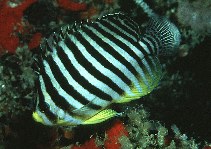| Family: |
Pomacanthidae (Angelfishes) |
| Max. size: |
12 cm TL (male/unsexed) |
| Environment: |
reef-associated; marine; depth range 7 - 100 m, non-migratory |
| Distribution: |
Indo-Pacific: Cocos-Keeling Atoll to the Society Islands, north to the Yaeyama Islands, south to the Great Barrier Reef. |
| Diagnosis: |
Dorsal spines (total): 13-13; Dorsal soft rays (total): 17-19; Anal spines: 3-3; Anal soft rays: 17-18. Description: Generally white with 8 brown bars extending through to dorsal and anal fins (becoming orange-yellow ventrally), the first running through the eye and the last running across the base of the caudal fin. A yellow bar runs in the middle of each white interspace on the side. A black spot is on the distal part of the soft portion of the dorsal fin (Ref. 1602). Body depth 1.5-1.7 in SL. Scales longitudinal series 42-48 (Ref. 90102). |
| Biology: |
Inhabits ledges and caves and crevices of steep outer reef slopes; occasionally found in clear lagoon reefs (Ref. 9071). It is secretive and rarely goes out more than a few centimeters from an escape hole (Ref. 9710). Forms pairs or small groups. Usually starves when kept in captivity (Ref. 48391). Often upside-down (Ref. 48636). Occasionally exported through the aquarium trade. Maximum depth reported taken from Ref. 128797. |
| IUCN Red List Status: |
Least Concern (LC); Date assessed: 09 October 2009 Ref. (130435)
|
| Threat to humans: |
harmless |
Source and more info: www.fishbase.org. For personal, classroom, and other internal use only. Not for publication.

